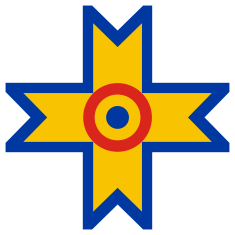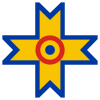Royal Romanian Air Force
This article needs additional citations for verification. (September 2007) |
| Royal Romanian Air Force | |
|---|---|
 Insignia | |
| Active | 1940–1944 |
| Country | |
| Type | Air Force |
| Role | Aerial warfare |
| Size | 322 |
| Part of | Royal Romanian forces |
| Garrison/HQ | Bucharest |
| Nickname(s) | ARR |
| Colours | Yellow and Blue |
| Engagements | World War II Battle of Stalingrad |
| Commanders | |
| Notable Commanders | Michael I of Romania |
| Insignia | |
| Roundel |  |
| Insignia |  |
The Air Arm of the Royal Romanian forces in World War II was officially named the Aeronautica Regala Romana (ARR), or the Romanian Royal Aeronautics, though it is more commonly referred to in English histories as the Forţele Aeriene Regale ale României (Royal Romanian Air Force, FARR), or simply Forţele Aeriene Române (Romanian Air Force). It provided support to land forces, carrying out reconnaissance and mounting air raids between other missions.
Insignia[]
The insignia of the FARR was a yellow cross (King Michael's monogram cross) in the fuselage and upper and lower wings, and the national colours on the tail, with a yellow engine cowling and vertical band on the fuselage. It was later changed at tricolor (red-yellow-blue) roundels on the fuselage and wings, and a tricolor band on the tail.
History[]
FARR flew aircraft from Germany and Italy, with their own and other foreign aircraft, as well as captured enemy aircraft. The Royal Romanian Air Force fought against the Magyar Királyi Honvéd Légierö (Royal Hungarian Air Force) during the Hungarian annexation of Northern Transylvania in 1940. The most basic unit of their formations was the squadron (Grup). The Romanian Air Force fought alongside the Luftwaffe during the advance into Ukraine and Crimea, until the Battle of Stalingrad, when the Southern Luftwaffe Command was installed in Bucharest. It also carried out some reconnaissance and patrol missions over the Black Sea alongside Bulgarian units. The Romanian Air Force was tasked with the air defence of the Ploiești oil installations, and also Bucharest against Allied air raids, and to protect Axis convoys in the Black Sea. These units fought against the USAAF and RAF during their raids against Romania.
The main models of aircraft used include the PZL P.24F, Hawker Hurricane, Heinkel He 112, Messerschmitt 109E and G types, Messerschmitt 110 (for night defence), IAR 80A were used too, alongside other types of interceptors used by the Luftwaffe units in area.
When the country was invaded by Soviet forces, King Michael I ordered Romanian forces to attack Axis forces, and the FARR was allied with the Soviet Air Forces against German and Hungarian forces in Transylvania and Slovakia, though some units continued to fight with the Axis in Luftwaffe volunteer units.
Romanian Air Aces[]

- Horia Agarici
- Constantin Cantacuzino
- Cristea Chirvăsuță
- Ioan Dicezare
- Alexandru Șerbănescu
- Daniel Vizanty
Structure[]

- Grupul 3° Picaj, Corpul 2° Aerian, Luftflotte 4, South Russia Front, Winter of 1943-44.
- Grupul 3° Picaj, Corpul 1° Aerian, Cioara-Dolcesti, Romania August 1944; under orders of Luftwaffe, Luftflotte Kommando 4 with commands in Debrecen, Hungary.
- 6th Fighter Group
- 7th Fighter Group
- 8th Fighter Group (1941–1943)
- 9th Fighter Group
- 5th Bomber Group
Aircraft companies[]
- Societatea Pentru Exploatări Tehnice (SET), 1923, Bucharest
- Industria Aeronautică Română (IAR), 1925, Braşov
- Întreprinderea de Construcții Aeronautice Românești (ICAR), 1932, Bucharest
Aircraft constructed under foreign license
- Heinkel He 111 H (30 examples by Brasov)
- Messerschmitt Bf 109G (15 109G-4a and 60 109G-6a IAR built examples by Brasov (1944-1947))
- Savoia-Marchetti SM.79JR (76 examples by Brasov)
- PZL P.11f (80 examples by IAR)
- PZL P.24E (50 examples by IAR)
- IAR 36 (Messerschmitt design) (5 examples by IAR)
Enemy aircraft interned or captured[]
As a result of the Soviet Invasion of Poland, a large number of Polish Air Force aircraft were interned in Romania. Also, some Soviet aircraft were captured during World War II, as well as a few American B-24 Liberator bombers.
Aircraft of RRAF[]
Aircraft manufactured in Romania until the end of World War II[]
All of the aircraft listed below were completed before the end of World War II. Prototypes are omitted from the list. Unless specified otherwise, all aircraft machine guns have the caliber of 7.92 mm. All of the data is sourced from:[1]
| Model | Type | Number | Armament |
|---|---|---|---|
| SET 7K | Training, communication, observation | 20 | 2 x Lewis guns (twin mount) |
| SET 7KB | Reconnaissance and observation | 20 | 2 x Lewis guns (twin mount) 1 x Vickers machine gun 6 x 12 kg bombs |
| SET 7KD | Communication | 20 | 1 x Lewis gun |
| Potez 25 | Reconnaissance bomber | 184 | 3 x machine guns 200 kg of bombs |
| IAR 37 | Light bomber | 50 | 4 x Browning machine guns 12 x 50 kg bombs |
| IAR 38 | Reconnaissance and artillery spotting | 75 | 3 x Browning machine guns 24 x 12 kg bombs |
| IAR 39 | Reconnaissance and light bomber | 255 | 3 x Browning machine guns 24 x 12 kg bombs |
| Fieseler Fi 156 | Reconnaissance and communications | 16 | 1 x MG 15 machine gun |
| PZL P.11F | Fighter | 95 | 4 x FN Browning machine guns 24 x 12 kg bombs (38) Grenade launchers (57) |
| PZL P.24E | Fighter | 25 | 2 x machine guns 2 x 20 mm autocannons 2 x 50 kg (110 lb) bombs Grenade launchers |
| Bf 109 G-4 | Fighter | 17 | 2 x 20 mm MG 151 autocannons 2 x 13 mm MG 131 heavy machine guns 1 x 250 kg/4 x 50 kg bomb(s) |
| IAR 80 | Fighter | 49 | 4 x FN Browning machine guns |
| IAR 80A | Fighter | 91 | 6 x FN Browning machine guns |
| IAR 80B | Fighter | 50 | 2 x 13.2 mm FN Browning heavy machine guns 4 x FN Browning machine guns |
| IAR 80C | Fighter | 50 | 2 x 20 mm Ikaria autocannons 4 x FN Browning machine guns |
| IAR 81 | Fighter and dive bomber | 50 | 6 x FN Browning machine guns (4 for 10 of them) 2 x 13.2 mm FN Browning heavy machine gun (10 of them) 1 x 225 bomb 2 x 50 kg bombs |
| IAR 81A | Fighter and dive bomber | 10 | 2 x 13.2 mm FN Browning heavy machine guns 4 x FN Browning machine guns 1 x 225 kg bomb 2 x 50 kg bombs |
| IAR 81C | Fighter | 148 | 2 x 20 mm MG 151 autocannons 2 x FN Browning machine guns Werfer-Granate 21 (1) |
| JRS-79B | Bomber | 36 | 5 x machine guns 1,575 kg of bombs |
| JRS-79B1 | Bomber | 31 | 1 x 20 mm Ikaria autocannon 7 x machine guns 1,400 kg of bombs |
| Savoia-Marchetti SM.62 | Flying boat | 5 | 4 x machine guns 600 kg of bombs |
References[]
- ^ Mark Axworthy, London: Arms and Armour, 1995, Third Axis, Fourth Ally: Romanian Armed Forces in the European War, 1941–1945, pp. 239-272
Bibliography[]
- Axworthy, Mark (September–October 1999). "Flank Guard: Romania's Advance on Stalingrad, Part Two". Air Enthusiast (65): 72–75. ISSN 0143-5450.
- Bernád, Dénes (July 1999). "Courrier des Lecteurs" [Readers' Letters]. Avions: Toute l'aéronautique et son histoire (in French) (76): 15–16. ISSN 1243-8650.
- Bernád, Dénes (May 1999). "Histoire des forces aeriennes royales roumaines pendant la Seconde Guerre Mondiale" [History of the Royal Romanian Air Force During the Second World War] (in French) (74): 7–13. ISSN 1243-8650. Cite journal requires
|journal=(help) - Bernád, Dénes (June 1999). "Histoire des forces aeriennes royales roumaines pendant la Seconde Guerre Mondiale" (in French) (75): 7–14. ISSN 1243-8650. Cite journal requires
|journal=(help)
External links[]
- Romanian Air Force
- Military history of Romania during World War II